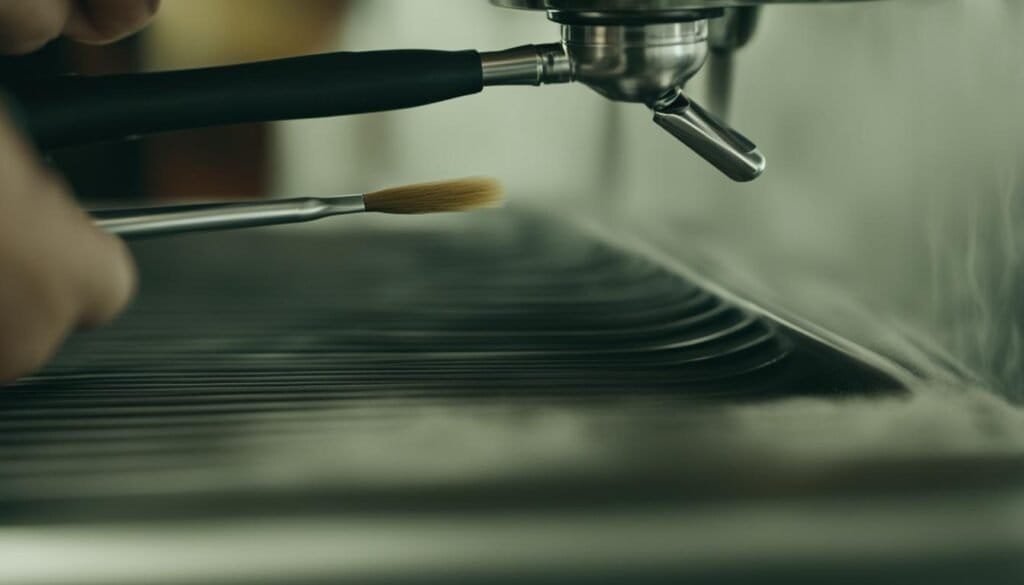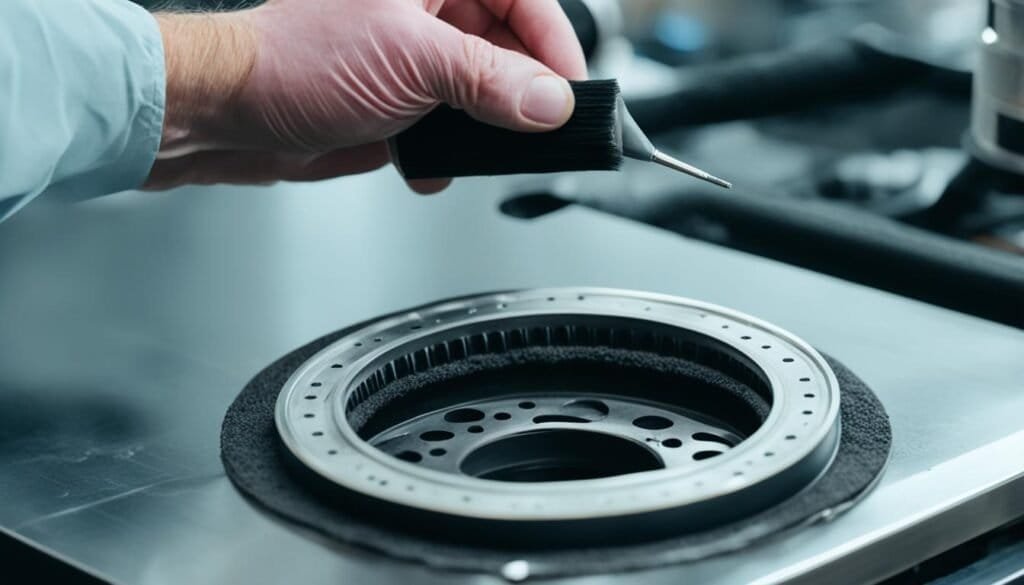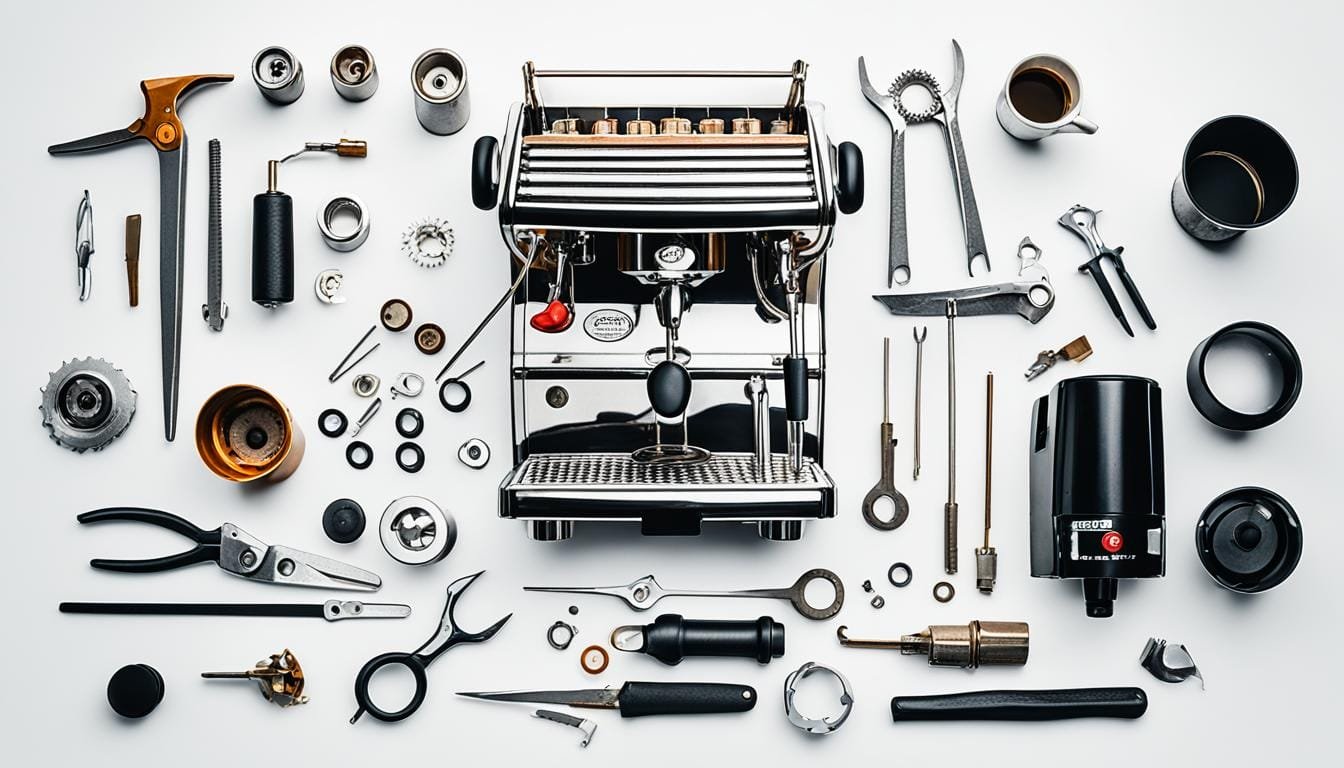Did you know that espresso machines can encounter a wide range of problems, from limescale buildup to inconsistent espresso shots? As an espresso machine owner, it’s crucial to have the knowledge and skills to troubleshoot these issues effectively. With the right techniques, you can fix common espresso machine problems and ensure the longevity of your beloved machine.
In this article, we will provide you with advanced espresso machine troubleshooting tips that will help you address complex issues and keep your machine running smoothly. From water softening to steam wand maintenance, we’ll cover all the essential aspects of espresso machine repair and maintenance. By following these tips and dedicating time to regular maintenance, you can enjoy delicious espresso shots without any hassles.
So, let’s dive into the world of espresso machine troubleshooting and discover the secrets of advanced espresso machine repair!
Key Takeaways:
- Understanding the common problems that espresso machines can encounter
- Importance of water softening for preventing limescale buildup
- Maintenance of steam wand and boiler water for optimal performance
- Inspection and maintenance of the group head gasket
- Fixing loose knobs and removing protective stickers
Importance of Water Softening for Espresso Machines
Water softening is an essential aspect of espresso machine maintenance that should not be overlooked. The buildup of limescale, which is caused by the minerals present in hard water, can lead to various problems and affect the performance of your espresso machine. It can clog valves, hinder heating elements, and even cause technical issues that may require costly repairs.
To combat limescale buildup and ensure the longevity of your espresso machine, regular water descaling or softening is crucial. Descaling involves the removal of limescale deposits from the internal components of the machine, while water softening aims to prevent the formation of limescale in the first place.
The Impact of Limescale Buildup
Limescale buildup can have significant negative effects on your espresso machine. Here are some common issues associated with limescale:
- Reduces water flow: Limescale can restrict the flow of water through the machine, resulting in decreased water pressure and slower extraction times.
- Affects heat transfer: The presence of limescale on heating elements can reduce their efficiency, leading to longer heating times and inconsistent temperature control.
- Impairs taste and aroma: Limescale can alter the flavor profile of your espresso, resulting in a less enjoyable cup of coffee.
Fortunately, there are water softening solutions available to combat limescale buildup. One effective method is to use a water filtration system with built-in water softening capabilities. These systems remove minerals from the water, preventing limescale formation and protecting your espresso machine.
Regular Maintenance for Optimal Performance
In addition to water softening, regular maintenance is essential to keep your espresso machine running smoothly. Here are a few maintenance tips:
- Clean the machine regularly: Regularly cleaning the machine’s internal and external components, such as the brew group and steam wand, helps prevent the accumulation of coffee residues and ensures the best-tasting espresso.
- Follow manufacturer guidelines: Always refer to the manufacturer’s instructions for specific maintenance tasks, such as backflushing and replacing filters.
- Monitor water quality: Keep an eye on the hardness of your water and the frequency of limescale buildup. Adjust your maintenance routine accordingly to maintain optimal performance.
In conclusion, water softening plays a vital role in ensuring the proper functioning and longevity of your espresso machine. Preventing limescale buildup through regular descaling or using a water filtration system with water softening capabilities can greatly improve the performance and taste of your espresso. Combined with regular maintenance, water softening solutions are key to enjoying exceptional coffee from your espresso machine for years to come.
Proper Maintenance of Steam Wand and Boiler Water
The steam wand and boiler water are critical components of an espresso machine. Regular maintenance of the steam wand is essential to prevent milk residue buildup and bacterial growth. For heat exchangers and double boilers, it’s important to periodically replace the boiler water to ensure optimal performance.
To maintain the steam wand:
- After each use, clean the steam wand with a damp cloth to remove any residue. This prevents clogging and ensures the quality of your milk frothing.
- For deeper cleaning, soak the steam wand in hot water or use a steam wand cleaner solution. This helps remove stubborn residue and prevents bacterial buildup.
- Check the steam wand tip for any blockages. Use a pin or small brush to clear any obstructions that may affect the steam flow.
To replace boiler water:
- Turn off the espresso machine and unplug it from the power source.
- Allow the machine to cool down.
- Locate the boiler drain plug or valve.
- Attach a hose to the drain plug or valve and drain the old water into a suitable container.
- Clean and rinse the boiler before refilling it with fresh water.
- Follow the manufacturer’s instructions to ensure the proper water level and avoid any airlocks.
- Once the boiler is filled with fresh water, flush the steam wand to remove any residual debris or air bubbles.
By following these recommended maintenance steps, you can ensure the quality of your espresso and prevent any issues related to the steam wand and boiler water. Regular maintenance helps prolong the lifespan of your espresso machine and ensures consistent, delicious coffee every time.

Group Head Gasket Inspection and Maintenance
The group head gasket plays a crucial role in the proper functioning of your espresso machine. It seals the portafilter to the group head, ensuring a secure connection and preventing any leaks or espresso grounds from entering the brewed coffee. Regular inspection and maintenance of the group head gasket are essential to maintain the efficiency and performance of your machine.
To inspect the group head gasket, remove the portafilter and closely examine the gasket for any signs of wear, tear, or damage. Look for cracks, splitting, or hardening, as these indicate that the gasket needs to be replaced. If you notice any issues with the gasket, it is important to take immediate action to avoid potential brewing problems.
If the group head gasket becomes stuck or difficult to remove, it is recommended to seek professional assistance. Trying to force the gasket out on your own may cause damage to the machine. A certified technician will have the necessary tools and expertise to safely remove and replace the gasket.
When it’s time to replace the group head gasket, there are a few steps you can take to make the process easier. Start by softening the gasket with hot water or using a food-grade lubricant, which will help loosen it and facilitate removal. Once the old gasket is removed, carefully clean the group head and ensure that there are no residual gasket particles left behind.
When inserting the new gasket, make sure it is properly aligned and securely fitted into the group head. A snug, tight fit is essential for achieving a proper seal. If the gasket is not inserted correctly, it may lead to leaks and affect the overall brewing performance of your machine.
Tips for Group Head Gasket Maintenance:
- Inspect the group head gasket regularly for signs of wear or damage.
- Seek professional assistance if the gasket becomes stuck or difficult to remove.
- Softening the gasket with hot water or using a food-grade lubricant can make the replacement process easier.
- Ensure the new gasket is properly aligned and securely fitted into the group head.
- Perform routine maintenance to prolong the lifespan of the group head gasket and ensure optimal brewing.
By paying attention to your group head gasket and performing regular maintenance, you can prevent brewing issues and ensure that your espresso machine consistently delivers exceptional coffee.

| Group Head Gasket Inspection | Gasket Replacement | Group Head Maintenance |
|---|---|---|
| Regularly inspect for wear and damage | Softening the gasket with hot water or using food-grade lubricant | Clean the group head thoroughly |
| Seek professional assistance if stuck | Properly align and securely fit the new gasket | Perform routine maintenance |
Fixing Loose Knobs and Removing Protective Stickers
Over time, knobs on your espresso machine may become loose, causing inconvenience during operation. Fortunately, tightening a loose knob is a simple fix that you can easily do yourself.
To tighten a loose knob on your espresso machine, follow these steps:
- First, identify the loose knob on your machine.
- Next, use a screwdriver that fits the screw on the knob.
- Insert the screwdriver into the screw and turn it gently clockwise to tighten the knob. Be careful not to overtighten.
- Test the knob to ensure it no longer feels loose.
By regularly checking and tightening loose knobs, you can ensure smooth operation and prevent any potential issues while using your espresso machine.
In addition to loose knobs, some espresso machines come with protective stickers or film on various parts. These stickers are typically used to protect the machine during shipping and can be safely removed without affecting the machine’s functionality.
To remove the protective stickers from your espresso machine, follow these steps:
- Locate the protective stickers on your machine.
- Gently peel off the stickers, starting from the corner or edge.
- If any residue remains, use a mild detergent or adhesive remover to clean the surface.
Removing these protective stickers not only improves the appearance of your machine but also helps prevent the accumulation of dust and dirt over time.
Why Remove Protective Stickers?
Removing the protective stickers from your espresso machine is essential to maintain cleanliness and aesthetic appeal. These stickers serve their purpose during transit but are no longer needed once the machine is set up. By removing them, you ensure that your machine remains in pristine condition, free from any residue or unsightly marks.
| Benefits of Removing Protective Stickers | Keep Your Machine Clean | Improve Aesthetic Appearance |
|---|---|---|
| Prevent dust and dirt accumulation on stickers | Enhance the visual appeal of your espresso machine | |
| Avoid sticky residue buildup | ||
| Ensure easy cleaning and maintenance |
Seasoning New Machines and Revitalizing Wands
When you first bring home a new espresso machine, it’s important to be aware that it may have a fresh coat of lubricant that needs time to season. This seasoning process is normal and allows the machine to operate at its best over time. As you use the machine more frequently, the lubricant will distribute evenly, enhancing the performance and ensuring longevity.
If you want to extend the lifespan of the steam wand and keep it in optimal condition, consider applying food-grade lubricant to the ball joint. This small step can help revitalize the wand and prevent any sticking or stiffness. By using a food-grade lubricant, you can ensure the safety and cleanliness of your coffee preparations.
Now, let’s talk about the steam wand knob. You may notice that it feels looser compared to other knobs on your espresso machine. This is intentional and serves a purpose. The looser feel is designed to prevent overtightening, which can lead to damage or breakage of the steam wand knob. So, when adjusting the steam wand knob, remember to do it gently and avoid turning it too tight.
If you find that you’re unable to lock the steam wand in place, it’s possible that the locking angle has been accidentally rotated. Take a moment to check the rotation of the locking angle and adjust it accordingly to ensure proper securing of the steam wand.
To summarize, seasoning new machines allows the lubricant to distribute evenly, improving performance over time. Revitalizing the steam wand with food-grade lubricant can extend its lifespan, while the looser feel of the steam wand knob prevents damage from overtightening. By following these tips, you can ensure the longevity and optimal functioning of your espresso machine.
Troubleshooting Portafilter Head and Grouphead Issues
The portafilter head and grouphead are critical components of your espresso machine. Issues such as coffee oil buildup or damaged chrome plating can have a significant impact on the quality of your espresso shots. To ensure the optimal performance of your machine, it is important to regularly clean the grouphead and replace necessary parts such as gaskets and shower screens.
Cleaning the grouphead is essential to remove any coffee residue, oils, or particles that can affect the flavor and consistency of your espresso. Use a grouphead detergent specifically designed for espresso machines to ensure effective cleaning without damaging the components. Avoid using regular cleaning detergents as they can be corrosive and harmful.
When cleaning the portafilter head, it is important to be cautious and avoid any contact between the cleaning detergent and the portafilter handles. Some cleaning detergents can cause damage to the material of the handles, resulting in discoloration or degradation.
Regularly inspect the chrome-plated brass on the portafilter head for any signs of wear or damage. If you notice any chips, scratches, or peeling, it is recommended to replace the portafilter head to maintain the integrity of your espresso shots.
Another crucial aspect of troubleshooting portafilter head and grouphead issues is the maintenance of gaskets and shower screens. Over time, gaskets can wear out, leading to leaks and inconsistent extraction. Inspect the gasket regularly and replace it if you notice any signs of deterioration or loss of elasticity. Similarly, the shower screen should also be inspected and cleaned regularly to prevent clogging and ensure an even distribution of water during extraction.
To visually guide you through the process of troubleshooting portafilter head and grouphead issues, refer to the following table:
| Troubleshooting Steps | Description |
|---|---|
| Cleaning the Grouphead | Use a grouphead detergent to remove coffee residue and oils. |
| Avoiding Contact with Cleaning Detergent | Ensure that the cleaning detergent does not come into contact with the portafilter handles. |
| Inspecting Portafilter Head | Regularly check the chrome-plated brass for any signs of wear or damage. |
| Maintaining Gaskets and Shower Screens | Inspect and replace gaskets if necessary, and clean shower screens regularly to prevent clogging. |
Remember, proper maintenance of the portafilter head and grouphead is essential for consistently delivering high-quality espresso. By following these troubleshooting tips and addressing any issues promptly, you can ensure the optimal performance of your espresso machine and enjoy exceptional coffee experiences.
Conclusion
Proper maintenance and troubleshooting techniques are crucial for ensuring the optimal performance of your espresso machine. By implementing the advanced troubleshooting tips discussed in this article, you can effectively address common issues and prevent major problems from occurring. Remember to regularly perform espresso machine maintenance tasks such as water softening, steam wand and boiler water upkeep, and group head gasket inspection to keep your machine running smoothly.
While taking a proactive approach to maintenance is essential, there may come a time when you need advanced espresso machine repair. In such cases, it’s highly recommended to consider professional coffee service providers like Smart Care maintenance services. Their experienced technicians can offer expert support and ensure your espresso machine receives the necessary repairs and maintenance it requires.
With regular maintenance and proper care, you can continue to deliver exceptional coffee experiences consistently. By prioritizing espresso machine maintenance, following troubleshooting tips, and utilizing professional services when needed, you can extend the lifespan of your machine and enjoy delicious espresso for years to come.
FAQ
What is the importance of water softening for espresso machines?
Water softening is crucial for preventing limescale buildup, which can clog valves, hinder heating elements, and cause technical issues. Performing regular water softening or descaling, along with using a water filtration system, can significantly improve the performance and lifespan of your espresso machine.
How do I properly maintain the steam wand and boiler water?
Regularly clean the steam wand to prevent milk residue buildup and bacterial growth. For heat exchangers and double boilers, periodically replace the boiler water to ensure optimal performance.
What should I do for group head gasket inspection and maintenance?
Regularly inspect and maintain the group head gasket to ensure a proper seal and prevent leakage. Use hot water or food-grade lubricant to soften the gasket before removing and replacing it. Properly insert the gasket and ensure a secure fit to maintain the efficiency of the espresso machine.
How can I fix loose knobs and remove protective stickers?
Use a screwdriver to tighten loose knobs. Additionally, remove any protective stickers or film to prevent dust or dirt accumulation.
How do I season new machines and revitalize wands?
Allow new machines to season over time. Apply food-grade lubricant to the steam wand’s ball joint to revitalize it. Ensure the steam wand knob is not overtightened and adjust the locking angle if needed.
How can I troubleshoot portafilter head and grouphead issues?
Regularly clean the grouphead and replace gaskets and shower screens to maintain the machine’s performance. Use grouphead detergent for cleaning, and avoid contact between the detergent and portafilter handles.
What is the importance of espresso machine maintenance and troubleshooting?
By following advanced troubleshooting tips and conducting regular maintenance, you can address common issues, prevent major problems, and ensure the optimal performance and longevity of your espresso machine. Professional maintenance services like Smart Care can provide expert support for enhanced coffee experiences.




